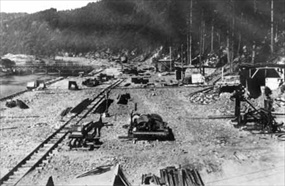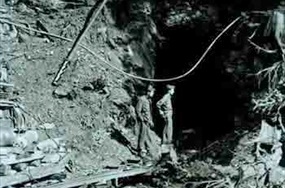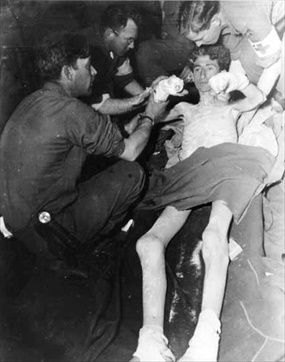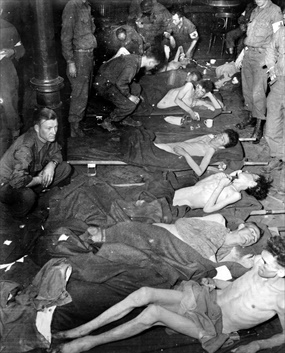STALAG IX B OPENS, BECOMES INFAMOUS GERMAN POW CAMP
Near Bad Orb, Hessen • December 1, 1939
On this date in 1939, 4 months since the outbreak of war in Europe, the German Wehrmacht (military) established a prisoner of war camp, Mannschafts-Stammlager IX B, outside Bad Orb, roughly 30 miles/48 km northeast of Frankfurt am Main. Over the course of the war Stalag IX B—Stalag being a contraction of “Stammlager,” or base camp—emerged as the most notorious of 42 prisoner of war (POW) camps for captured Allied ground forces. Other POW camps were established specifically for captured airmen (Stalag Luft, 6 camps), officers (Oflags, 4 camps) and naval personnel (Marlag, 1 camp), to name the principal types of German POW camps. The Soviet Union being the exception, Great Britain, France, the United States, Germany, Italy, and Japan all signed the Geneva Convention of 1929 on the correct treatment of prisoners. The Japanese Diet (parliament) refused to ratify the treaty and the Soviets refused to even sign on.
The legal distinction between POW camps and the thousands of concentration, labor, and death camps in the Reich and German-occupied territories is important. Under the 1929 Geneva Convention, captors may assign POWs below non-commissioned rank (i.e., enlisted grade personnel) to work details that did not support war-related industries. General factory, forestry, construction, and agricultural work was permitted; munitions, gun, aircraft, etc., manufacturing and work that posed a risk to a POW’s health and safety were off limits.
During Adolf Hitler’s winter 1944–45 Ardennes Offensive (aka Battle of the Bulge) fought in Belgium, Northeast France, and Luxembourg, over 23,000 U.S. soldiers became enemy captives. This sudden infusion of a quarter more Americans than were already in the German POW camp system produced chaos at this late stage in the war, straining the ability of authorities to supervise and manage the system adequately.
Bad Orb’s Stalag IX B was negatively impacted by the intake of thousands of Americans captured during the Battle of the Bulge (mostly privates), the first 976 arriving on this date, December 26, 1944. A month later over 4,000 GIs shared Stalag IX B with French, Belgian, Polish, Czech, British, Serbian, Soviet, and Italian captives after Benito Mussolini’s fall from power on July 25, 1943. Camp personnel had received little to no warning that American POWs would be arriving (still more captured GIs would arrive), so they made no preparations for handling them. Nearly 1,500 GIs were forced to sleep on bare floors, many without blankets, in mostly unheated rooms. Toilet facilities were primitive, hygiene facilities nonexistent. Overcrowding worsened with fresh intakes of 2,000 British captives. Food rations nosedived and deaths from disease and severe malnutrition soared. With 10,000 more prisoners than it could accommodate, Stalag IX B’s infrastructure was near collapse, never to recover.
Culling the U.S. prisoner population at Stalag IX B occurred in early February 1945. That’s when the camp commandant was ordered to relocate 350 self-identified and suspected American Jews, along with noted camp trouble-makers and some American “volunteers,” to a new labor camp in Eastern Germany. At Berga an der Elster American POWs would engage in mining operations for (learned later) a planned underground synthetic oil plant for the Wehrmacht or, per other sources, a munitions factory. The POWs’ transfer to an obvious military project at Berga violated the 1929 Geneva Convention.
On February 13, 1945, 349 Americans stepped into a hell beyond imagining. Berga was a slave-labor camp to which 3,421 overwhelmingly Jewish wretches were dispatched from Buchenwald concentration camp. Their tunneling work was extremely hazardous and deadly; in fact, Camp Berga was lethal to 20 percent of Stalag IX B GIs. (See photo essay below.) Their brutal 9‑week ordeal culminated in a forced march of some 1,500 Berga prisoners that ended on April 23. As recorded by an American survivor of the march, 286 GIs departed Berga for Bavaria, 48 died on the walk, 30 were hospitalized along the way, and about 166 were liberated by the arrival of American troops. Forty-two GIs were unaccounted for. Their liberation came some 3 weeks after Stalag IX B, their former POW camp, had been liberated.
U.S. POWs at Berga an der Elster Slave Labor Camp, February to April 1945
 |  |
Above: Berga an der Elster (aka Berga am Elster) was a forced labor subcamp of the notorious Buchenwald concentration camp in Thueringen, Eastern Germany. Camp Berga was located on the outskirts of Schlieben, a village in southwestern Brandenburg, Eastern Germany. According to most sources the underground tunnels and mine shafts at Berga would become a complex that would transform brown coal into synthetic fuel products. The Allied strategic bombing campaign had severely reduced the Reich’s ability to produce sufficient types of fuel for the Wehrmacht in above-ground extraction and refining facilities, so Germans sought subterranean locations where slave laborers numbering in the hundreds of thousands produced warplanes, ballistic missiles, and other articles needed for the German war effort. The 2 photos above show some of the 17 entrances to tunnels and mine shafts in Zikraer Berg mountain where free German civilian miners and slave laborers transferred from nearby concentration camps, including 349 American POWs from Stalag IX B in Hessen, were put to work. Berga is the only known instance of captured American soldiers being used as slave laborers at a Nazi prison camp. German civilians drilled and dynamited the slate loose; slave laborers broke up the rocks so they could be shoveled or lifted into wheeled mining trams/carts and dumped into the nearby Elster River. Some of the interconnected tunnels and mine shafts were 150 feet/9 m below ground and formed cavernous rooms.
 |  |
Left: Pvt. Alvin L. Abrams, 20, of Philadelphia, Pennsylvania, was one of the Jewish American POWs segregated at Stalag IX B and sent on to Berga in February 1945. After Berga was evacuated on April 4 or 5, 1945, Abrams was found at the prison hospital in Fuchsmuehl near the Czech border by soldiers of George S. Patton Jr’s Third U.S. Army after barely surviving the 2½‑week, 100‑mile/161 km death march into Bavaria. Only the timely arrival of the 11th Armored Division at war’s end saved the captives, U.S. and European nationals, from certain death. Abrams, head resting on his upraised arm, is fifth from the bottom in the adjacent photo. After the war Sgt. Erwin Metz, the sadist who supervised the American camp and two dozen Berga camp guards and was chiefly responsible for camp’s chaotic and inhumane conditions and April’s forced march, saw his death sentence communed to 20 years’ imprisonment but was freed after a mere nine. Metz’s superior, Capt. Ludwig Merz, who was responsible for the work details, walked free after 5 years in prison. Project and constructions manager for Berga’s mining operation, one SS Lt. Willy Hack, was hanged by Communist authorities in the Soviet-occupied zone of Germany in 1952.
![]()
Right: Lying on stretchers are some of the 63 emaciated POWs recently intercepted by their American liberators on the Berga death march. Berga prisoners had no protective clothing, hard hats, gloves, safety shoes, or masks; many died from pulmonary disease due to dust inhalation from tunneling through white rock using pneumatic drills, 6‑ft/1.8‑m-long steel bits, and explosives. Severe malnutrition was another cause of death: prisoners worked 8‑hour shifts (6 a.m. to 2 p.m. and 2 p.m. to 10 p.m.) 7 days a week with no food, water, or rest and were fed only starvation rations—in other words, prisoners were intentionally and methodically starved and worked to death. (Germans had a term for that: Vernichtung durch Arbeit, “work to death.”) Prisoners were brutalized, beaten regularly with a shovel, a rubber hose, or spiked with a pick. They slept in ghastly bedbug-, flea-, and lice-infested triple-decker bunk beds, and they were never allowed to bathe or change their clothes. Diarrhea, dysentery, and typhus raged in the camp; ulcerated wounds, pneumonia, worksite accidents, and suicides took their toll. Of the 349 GIs in Stalag IX B February’s consignment, 70 died within 2 months at Berga—the highest POW fatality rate of any camp where Americans were incarcerated in Europe. In the lead-up to the Cold War with the Soviets and in a perverse atmosphere of postwar political correctness vis-à-vis the West Germans, U.S. military authorities hushed up any talk of Berga’s horrific war crimes. Many soldiers who had survived Berga were required to sign a “security certificate,” forbidding them from ever disclosing the details of their imprisonment. For these reasons, Berga is not well known in the literature.
Nazi Labor and Death Camp Berga an der Elster, 1944–1945
![]()

 History buffs, there is good news! The Daily Chronicles of World War II is now available as an ebook for $4.99 on Amazon.com. Containing a year’s worth of dated entries from this website, the ebook brings the story of this tumultuous era to life in a compelling, authoritative, and succinct manner. Featuring inventive navigation aids, the ebook enables readers to instantly move forward or backward by month and date to different dated entries. Simple and elegant! Click
History buffs, there is good news! The Daily Chronicles of World War II is now available as an ebook for $4.99 on Amazon.com. Containing a year’s worth of dated entries from this website, the ebook brings the story of this tumultuous era to life in a compelling, authoritative, and succinct manner. Featuring inventive navigation aids, the ebook enables readers to instantly move forward or backward by month and date to different dated entries. Simple and elegant! Click 











